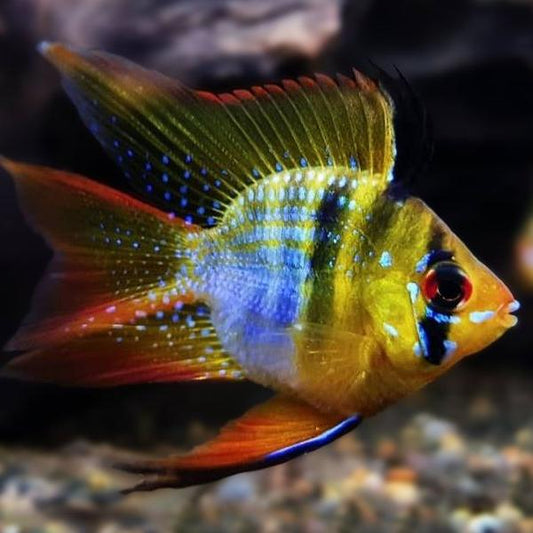German Ram Cichlid Collection
-
Mixed Color Ram Cichlids | Discounted Pack
Regular price From $60.00 USDRegular priceUnit price per$2.00 USDSale price From $60.00 USD -
German Blue Balloon Ram Cichlid
Regular price From $45.00 USDRegular priceUnit price per$2.00 USDSale price From $45.00 USD -
 Sold out
Sold outGerman Blue Ram Cichlid
Regular price From $45.00 USDRegular priceUnit price per$2.00 USDSale price From $45.00 USDSold out -
German Gold Balloon Ram Cichlid
Regular price From $45.00 USDRegular priceUnit price per$2.00 USDSale price From $45.00 USD -
 Sold out
Sold outGerman Gold Ram Cichlid
Regular price From $45.00 USDRegular priceUnit price per$2.00 USDSale price From $45.00 USDSold out -
Electric Blue Balloon Ram Cichlid
Regular price From $45.00 USDRegular priceUnit price per$2.00 USDSale price From $45.00 USD -
 Sold out
Sold outElectric Blue Ram Cichlid
Regular price From $45.00 USDRegular priceUnit price per$2.00 USDSale price From $45.00 USDSold out -
 Sold out
Sold outBolivian Ram Cichlid
Regular price $35.00 USDRegular priceUnit price per$2.00 USDSale price $35.00 USDSold out -
 Sold out
Sold outDark Knight Ram Cichlid (Rare)
Regular price From $30.00 USDRegular priceUnit price per$2.00 USDSale price From $30.00 USDSold out
FAQs about the German Ram Cichlid Fish
Are Blue Ram Cichlids Freshwater?
Yes, Blue Ram Cichlids (Mikrogeophagus ramirezi) are freshwater fish. They are native to the Orinoco River basin in South America and thrive in warm, soft, slightly acidic water. Blue Rams are popular in home aquariums due to their bright colors and peaceful nature.
Can a Gold Ram Cichlid Be in a 10-Gallon Tank?
Yes, a Gold Ram Cichlid can be kept in a 10-gallon tank, but it is not ideal. A 20-gallon tank is recommended to provide more space for swimming and to maintain stable water parameters. If keeping a Gold Ram in a 10-gallon tank, ensure it is the only fish or that it has minimal tank mates to reduce stress.
Can a Ram Cichlid Be in a 10-Gallon Tank?
A single Ram Cichlid can be housed in a 10-gallon tank, but for optimal health and comfort, a larger tank (20 gallons or more) is better. A small tank can lead to fluctuations in water quality, which can stress the fish. Ensure adequate filtration and regular water changes if using a 10-gallon tank.
Can Electric Blue Rams Breed with Blue Ram Cichlids?
Yes, Electric Blue Rams can breed with regular Blue Ram Cichlids. Both belong to the same species, Mikrogeophagus ramirezi, and can interbreed to produce viable offspring. The fry may show a mix of color traits from both parents
Can I Feed My Ram Cichlid Exclusively Bloodworms?
No, it is not advisable to feed Ram Cichlids exclusively bloodworms. While they enjoy bloodworms as a treat, a varied diet that includes high-quality flake or pellet food, brine shrimp, and vegetable matter is essential for balanced nutrition and long-term health.
Can I Use Flourite Gravel with Ram Cichlids?
Yes, Flourite gravel can be used with Ram Cichlids. It is a substrate designed for planted aquariums and can provide a natural environment that Ram Cichlids appreciate. Ensure the substrate is not sharp, as cichlids may dig and sift through it.
Can You Keep Crayfish with Blue Ram Cichlids?
It is generally not recommended to keep crayfish with Blue Ram Cichlids. Crayfish can be aggressive and may harm or stress the cichlids, especially at night when the fish are less active. A more peaceful setup without crayfish is ideal for Blue Ram Cichlids.
Can You Keep Multiple Types of Ram Cichlids Together?
Yes, you can keep multiple types of Ram Cichlids together, such as Blue Rams, Gold Rams, and Electric Blue Rams, as long as the tank is large enough to accommodate them (at least 30 gallons). Ensure plenty of hiding spots and territory to minimize aggression.
How Big Does a Blue Ram Cichlid Get?
Blue Ram Cichlids typically grow to about 2-3 inches (5-7 cm) in length. They are relatively small cichlids, making them suitable for medium-sized tanks with peaceful tank mates.
How Much Salt to Treat a Sick Ram Cichlid?
To treat a sick Ram Cichlid with salt, use 1 tablespoon of aquarium salt per 5 gallons of water. Dissolve the salt before adding it to the tank, and avoid overuse, as it can stress the fish. Salt treatments should be temporary and only for specific conditions like mild infections or parasites.
How to Breed Electric Blue Ram Cichlid
To breed Electric Blue Ram Cichlids:
- Set up a breeding tank with warm water (82°F/28°C) and soft, slightly acidic pH (6.0-6.5).
- Provide flat surfaces or caves for egg-laying.
- Condition the pair with high-quality live or frozen foods.
- Observe spawning and protect the eggs from tank mates.
- Care for the fry with infusoria or newly hatched brine shrimp after hatching.









